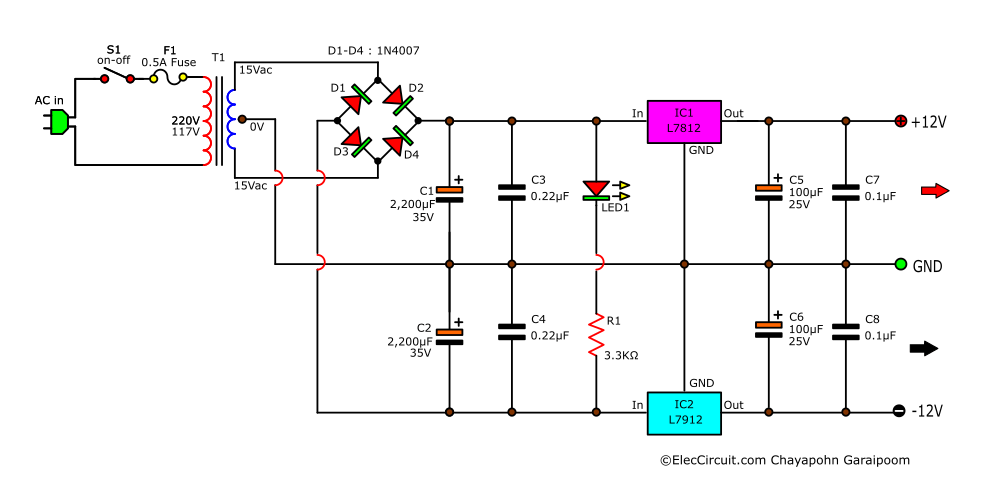Hi
I am building a dual 12 volt power supply. I am unsure what voltage led is required. I was hoping to replace it with a IN4007 but I realise they do different things.

thanks for any help
I am building a dual 12 volt power supply. I am unsure what voltage led is required. I was hoping to replace it with a IN4007 but I realise they do different things.

thanks for any help
LED's typically have on voltages of ~2v, so with the rectified supply rails of approx +-21v, the current set by R1 will be (21x2 - 2)v/2.7k = 15mA. If you do not want the LED, you can simply omit it and R1, saving 15mA consumption
I normally assume around 1.5V for a LED (it depends on the color).
15mA I find too much. I use 3-7mA depending on the purpose and color.
I prefer having a LED-lamp to indicate when power is ON. I would use a 4K7 resistor.
15mA I find too much. I use 3-7mA depending on the purpose and color.
I prefer having a LED-lamp to indicate when power is ON. I would use a 4K7 resistor.
Obvious question is obvious.
WHY do you want to replace the led ?
What do you hope to achieve by doing so ?
WHY do you want to replace the led ?
What do you hope to achieve by doing so ?
Your regulators need rectifiers around them for supply-cycling protection -- 100uF is large enough to kill them when the supply drops.
Check the mfg's data sheet.
Regards
Check the mfg's data sheet.
Regards
The LED and R1 are connected across about 42VDC. The LED drops about 2V so that leaves about 40V on R1 so the LED current is 40/2700 ~= 15mA. Different color LED have slightly different voltage drops but it is a small part of the total voltage so it has little effect. 15mA may be too bright for a modern LED so you may want to increase the value of R1 to maybe 10K. led - Calculating forward voltage for a string of fairy lights: multimeter shows "1" - Electrical Engineering Stack Exchange
It appears that the OP isn't entirely aware of how to use LEDs.
Most LEDs fall into a range of operating voltages between about 1.7V and 2.7V depending on their colour and composition.
In this application this is "largely" immaterial.
What is important is the current that will be flowing through the LED.
You need to know the "raw" DC voltage that is to be applied across the LED.
In this case that will be approximately 30V x 1.4142 = 42V DC.
The maximum current that can be allowed to flow through the LED should be set to be between about 5mA and 10mA.
If VLED = 1.7V and ILED = 5mA.
R = (42 - 1.7) / 5mA = 8.06 K Ohms.
This is not a common value so we choose the closest value. In reality anything between 4K7 and 10K would be fine.
If VLED is 2.7V and ILED = 10mA
R = (42 - 2.7) / 10mA = 3.9K
Again anything around this value will be OK.
I hope this illustrates that the VLED is largely immaterial, it will, within limits, only slightly affect the current flowing through the LED.
Most LEDs fall into a range of operating voltages between about 1.7V and 2.7V depending on their colour and composition.
In this application this is "largely" immaterial.
What is important is the current that will be flowing through the LED.
You need to know the "raw" DC voltage that is to be applied across the LED.
In this case that will be approximately 30V x 1.4142 = 42V DC.
The maximum current that can be allowed to flow through the LED should be set to be between about 5mA and 10mA.
If VLED = 1.7V and ILED = 5mA.
R = (42 - 1.7) / 5mA = 8.06 K Ohms.
This is not a common value so we choose the closest value. In reality anything between 4K7 and 10K would be fine.
If VLED is 2.7V and ILED = 10mA
R = (42 - 2.7) / 10mA = 3.9K
Again anything around this value will be OK.
I hope this illustrates that the VLED is largely immaterial, it will, within limits, only slightly affect the current flowing through the LED.
- Home
- Amplifiers
- Power Supplies
- 12v power supply